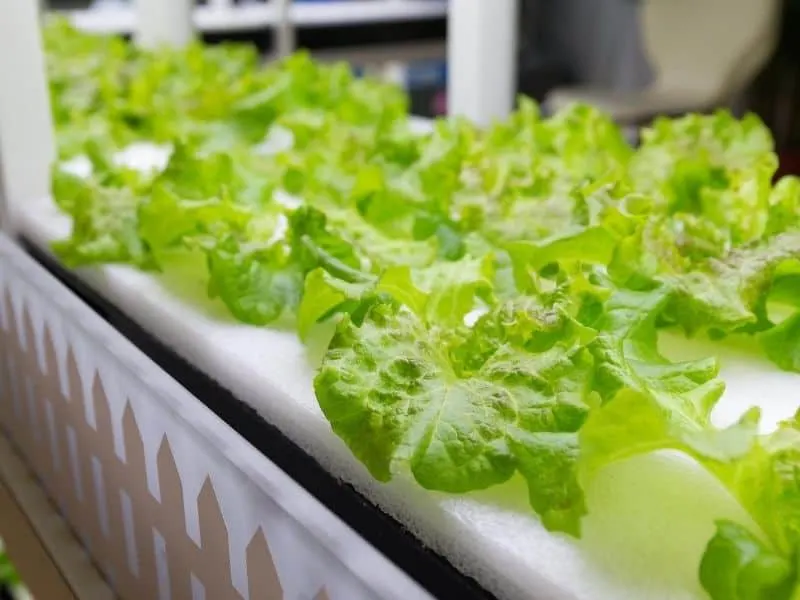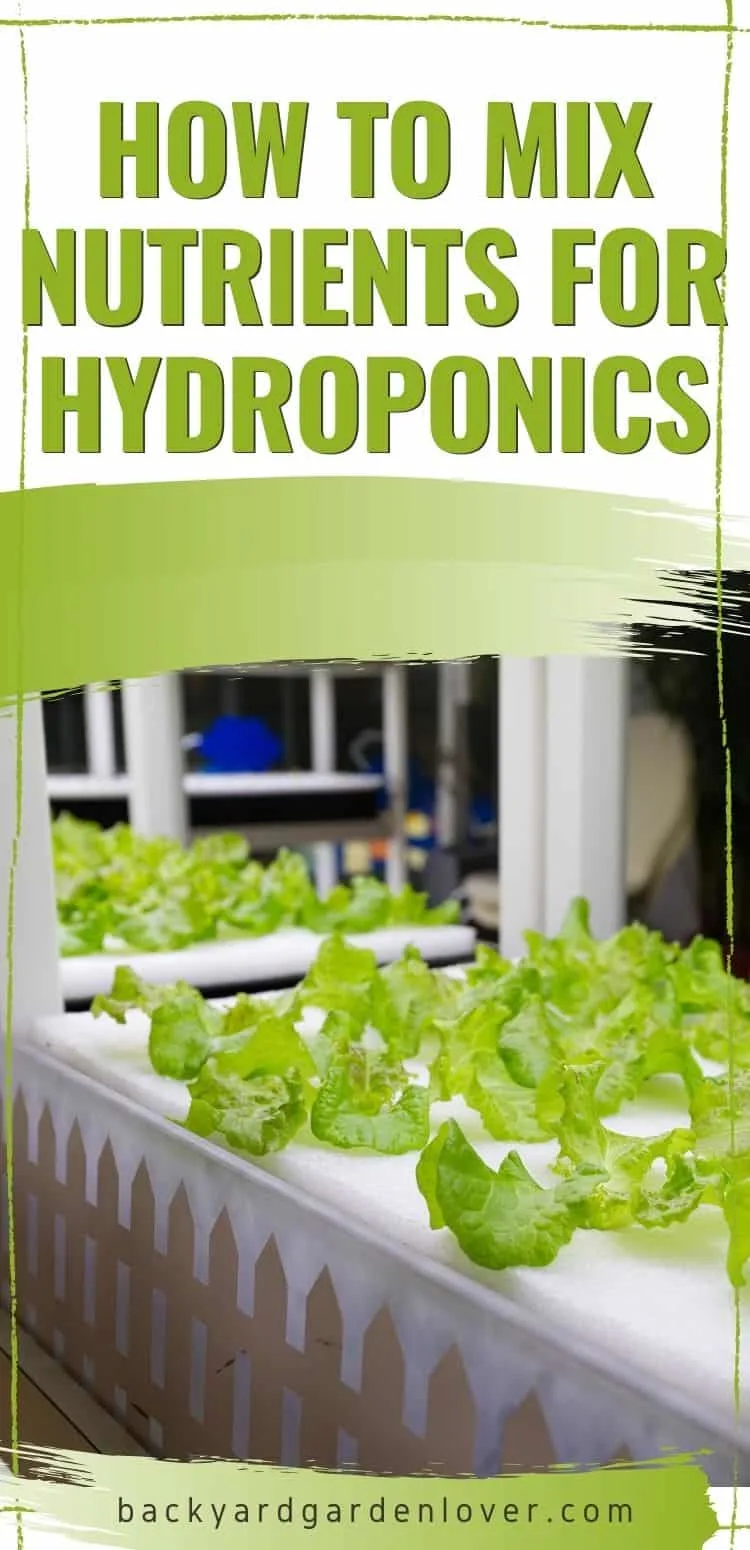There’s one thing all hydroponics systems have in common: a nutrient solution. Just follow our simple tips: learn how to mix nutrients for hydroponics and keep a healthy and potent nutrient reservoir in your grow room.
Our Beginner’s Guide To Hydroponics is on sale for a short time. Check it out!

Simon’s Simple Hydroponics Plans Giant Ebook – learn everything you need to know to grow an amazing hydroponic garden.
How To Mix Hydroponic Nutrients
- If using chlorinated tap water, fill the reservoir or mixing bin and let the water sit for a day to dissipate the chlorine.
- After adding the nutrients, let it settle for an hour or two before checking pH. Optimum pH range is 5.5-6.5 (6.0 is ideal)
- Keep the solution between 65-75 degrees (60 min, 80 max). You may have to insulate the reservoir. Hot solution breeds bad bacteria and will cook those tender roots. If nothing else works, you can get a chiller, but they are expensive!
- How much solution will you need? This will take some trial and error for your particular unit. In my 40 gallon reservoir, I use 36 gallons. This is for a 4′ x 4′ ebb & flow plot. You need enough solution so that when the pump kicks on and most of the solution is moved to the plants, your pump is not left sucking air.
- You must aerate the solution 24/7 to keep down the anaerobic bacteria (bad bugs) and oxygenate the roots. You can use an inexpensive aquarium pump, and drop a large bubbler stone in the reservoir. This is important for maintaining hydroponics nutrients.
Quick reservoir tips
- Put a cheap floating aquarium thermometer in the vat. Tie it to the tubing with rubber bands so you can find it.
- Enclose your pump in a strainer bag or nylon hose to keep debris out of it.
- A tablespoon of hydrogen peroxide in the reservoir weekly will cut down on algae and bacteria growth.
- If you find the sound of aquarium air pumps annoying as I do, use a special aerator that sits right in the reservoir. This one is great. Order two if you are making a lettuce raft at the same time: one for the reservoir and one for the lettuce bin.
Stella’s super simple solution system – How to mix nutrients for hydroponics
How to mix the first solution batch
Maintaining hydroponics nutrients…Follow Stella’s cool mixing chart for the initial batch of grow juice (we recommend General Hydroponics Flora Series nutrients.*)
Warning: do not mix the nutrient concentrates together. Add them one by one into the water, and stir starting with the Flora Micro, then Grow, then Bloom.
Mix in that order to avoid elements bonding and falling out of solution.
For a 40 gallon reservoir, I mix up 36 gallons. Adjust the pH to between 5.5-6.5.
Make sure and record the initial volume. Keep a small notebook in your grow room.
*Use Hardwater Micro instead of regular Micro if you have greater than 70 ppm calcium in your tap water.
Topping up the reservoir
The level of the solution in the reservoir will drop in time due to plant uptake and evaporation. You need to top it up every 3-4 days, when
necessary. Make sure to record each gallon added for top-up.
WARNING: Top up with WATER only, NOT more nutrient solution. Why? Only the water is evaporating, not the minerals. If you keep adding more nutrient solution, you increase the strength of the mix. It will get stronger and stronger each top-up, and might even kill your plants. So, top up with pH-balanced water only. And record the volume of each top up.
When do you mix a whole new batch?
Some of the books say to drain your system and mix a new batch every week (ouch!). Some say every 2 weeks. Some even recommend monthly.
Maintaining hydroponics nutrients doesn’t have to be complicated or take much time or waste those valuable nutes. We follow the 50% method and have found it works great for us.
This is how it works:
When you have replaced a total of 50% of the original solution amount by topping up, (in our case 18 gallons), stop topping up at that point. Then allow the level to deplete naturally until it reaches the top of your pump. Then it’s time to empty the reservoir out and mix up a whole new batch.
*Tip: If this is an ebb & flow setup, now is the time to flush the pots to remove built-up salts from the grow medium. Gingerly drench each pot from the top with plenty of clean water. Give the plants a gentle shower, too. Then let it all drain. Now empty your reservoir and fill up with a fresh batch of nutrient solution.
*We have an easy way to siphon out the vat without getting a mouthful of muck, too! (See KISS box below).
*Don’t miss the link at the end of the page to a special and useful tool for fine-tuning your nutrient solution.
The only nutrient solution you’ll ever need
General Hydroponics Flora Series is the best, most widely used nutrient solution system on the market. It was chosen by NASA for its hydroponics program. It is readily available and reasonably priced. GH Flora is a three-part system and comes in quarts or gallons. We buy it by the gallon and it gets us through many gardens. Don’t forget to order the Hardwater Micro if you have hard tap water (Calcium greater than 70 ppm).
Forget the mixing directions on the bottles, we figured it all out for you in Stella’s Flora Nutrient Mixing Chart. Print it out and stick it on the wall!

K.I.S.S. (Keep It Simple, Simon)
How to siphon out the old nutrient solution without getting a mouthful of muck:
- You need a garden hose that will reach from the reservoir to your outside water faucet.
- Attach the hose to the faucet and place the other end into and on the floor of the reservoir.
- Turn on the water until the hose is completely filled with water and flowing into the reservoir.
- Go outside, turn off the water. Unscrew the hose from the faucet and quickly drop the hose down on the ground (which must be lower than the level of the reservoir bottom inside). Do NOT suck on the hose!
- The solution in the reservoir will start draining by itself.
Too cool. Trust me. I learned this one the hard way.
How to know your solution is still potent
The simple 50% method described above works well for a wide variety of systems and types of crops. We use it for all our gardens and heartily endorse it for the average home Hydro enthusiast.
But… If you find yourself wondering…hmmm… I wonder how strong my grow juice really is today? (After the 5th top-up with fresh water)
Or… My plants are ailing… I wonder if they’re getting enough to eat?
If you’re the type who’s just gotta know… Or you’re a techie-type… Or a control freak… We’ve got just the thing for you… an EC meter!
This baby gives you an instant-read of how weak or strong your nutrient mix is. Why is this useful?
- It allows you to fine-tune your nutrients for optimum growth for different crops (Yep, we have a chart for you).
- Useful for troubleshooting when things go awry.
- Allows for tight quality control on a daily basis. All commercial greenhouses use them.
- It satisfies your “Need To Know” 🙂
*** You don’t NEED one of these, but you might WANT one.
I hope you feel better prepared to mix up your hydroponic nutrients now that you know how to mix nutrients for hydroponics.
Learn all about EC meters or truncheons here.

Stella and Simon, a couple of back-to-the-land, baby boomer enthusiasts, have embraced the world of homemade hydroponics on their three-acre plot of Florida piney woods. Their journey began after drawing inspiration from Epcot Center’s hydroponics exhibit, and they've delved into various hydroponic methods, experimenting with different systems, configurations, and crops both indoors and outdoors. Their expertise culminated in the creation of an innovative homemade hydroponics greenhouse, documented in their book, Simon’s Super Simple On-the-Grid, Off-the-Grid Hydroponic/Aquaponic Survival Greenhouse.



Easy Home Hydroponics Setup
Wednesday 17th of August 2022
[…] nutrient solution must be kept cool … between 60-75 degrees. This means you can’t keep the vat out on a […]
What Is A Hydroponic EC Meter And How To Use It
Thursday 21st of January 2021
[…] hydroponic greenhouses use EC meters inline with their nutrient systems: it’s usually automated to adjust the solution as […]
Hydroponics Advantages And Disadvantages
Wednesday 20th of January 2021
[…] honestly, the produce was not that tasty. But that’s all changed due to modern methods and superior nutrients. Grocery-bought vegetables have been bred to ship tough, last for weeks, and look great on the […]
Hydroponic Gardening - Clean, Green And Nutritious!
Tuesday 1st of December 2020
[…] Apart from being soil-less, all hydroponic gardens have another thing in common… the use of a specialized nutrient solution to feed them. These formulations have all the vitamins, nutrients, and trace minerals a plant needs for growth. This special mix must be used in hydroponics; you can’t just throw Miracle Grow in your nutrient reservoir! […]
DIY Ebb And Flow Hydroponic System {Step By Step With Pictures}
Tuesday 1st of December 2020
[…] nutrient reservoir must be kept cool (55-70°). This is especially important for cool-season crops like lettuce and […]